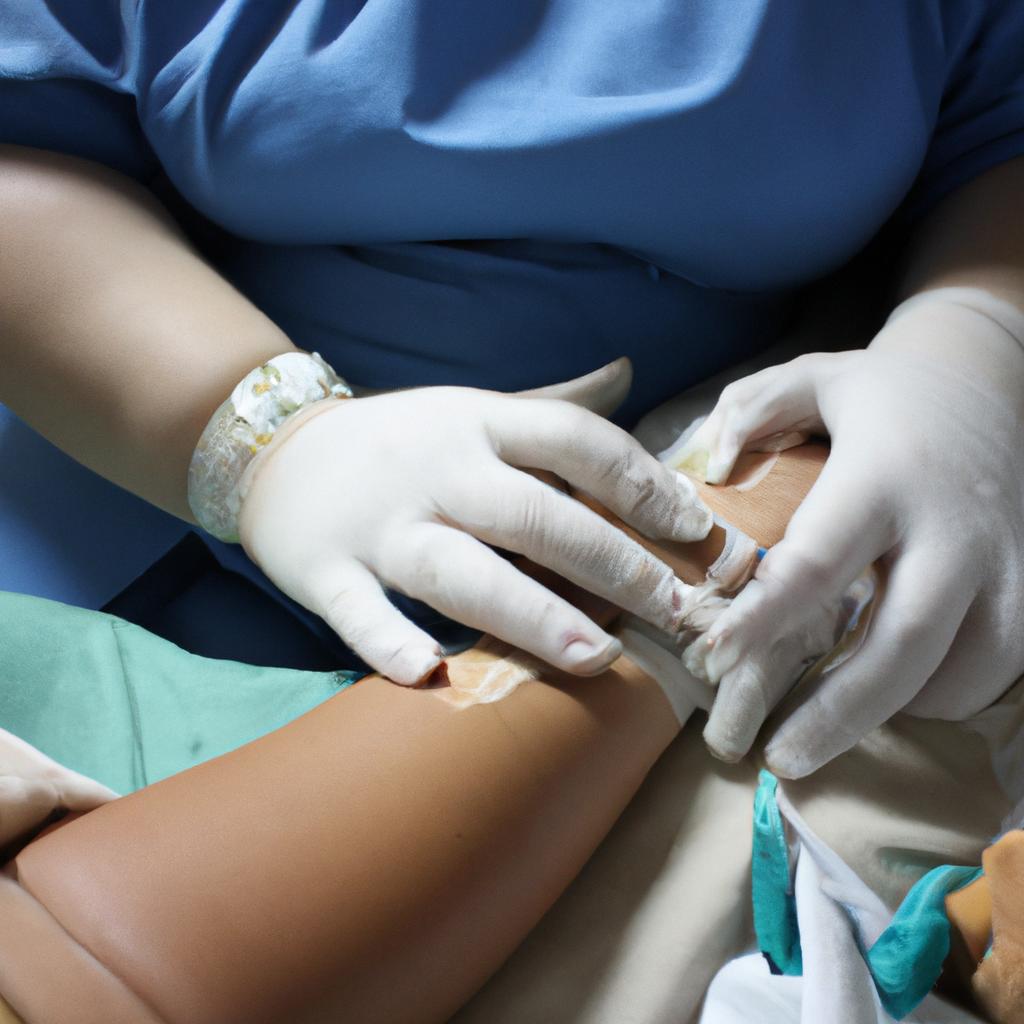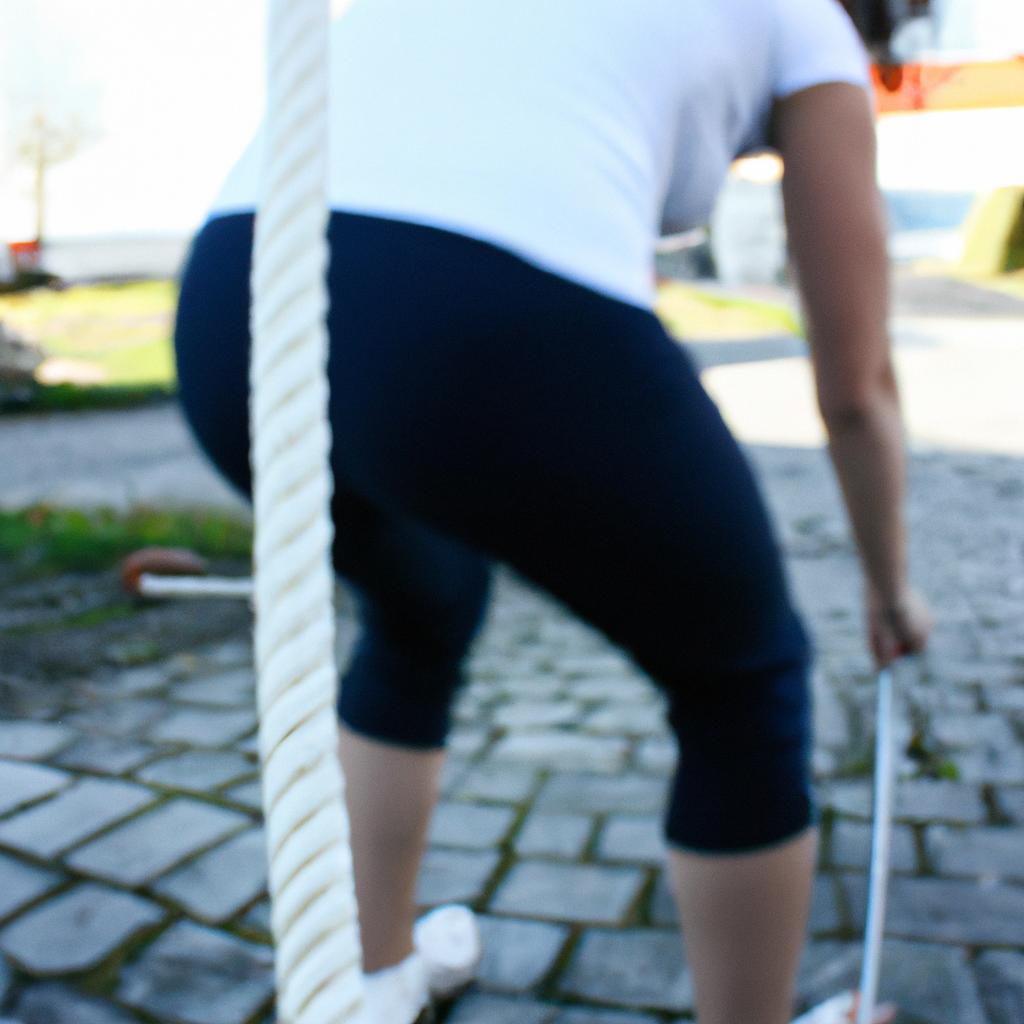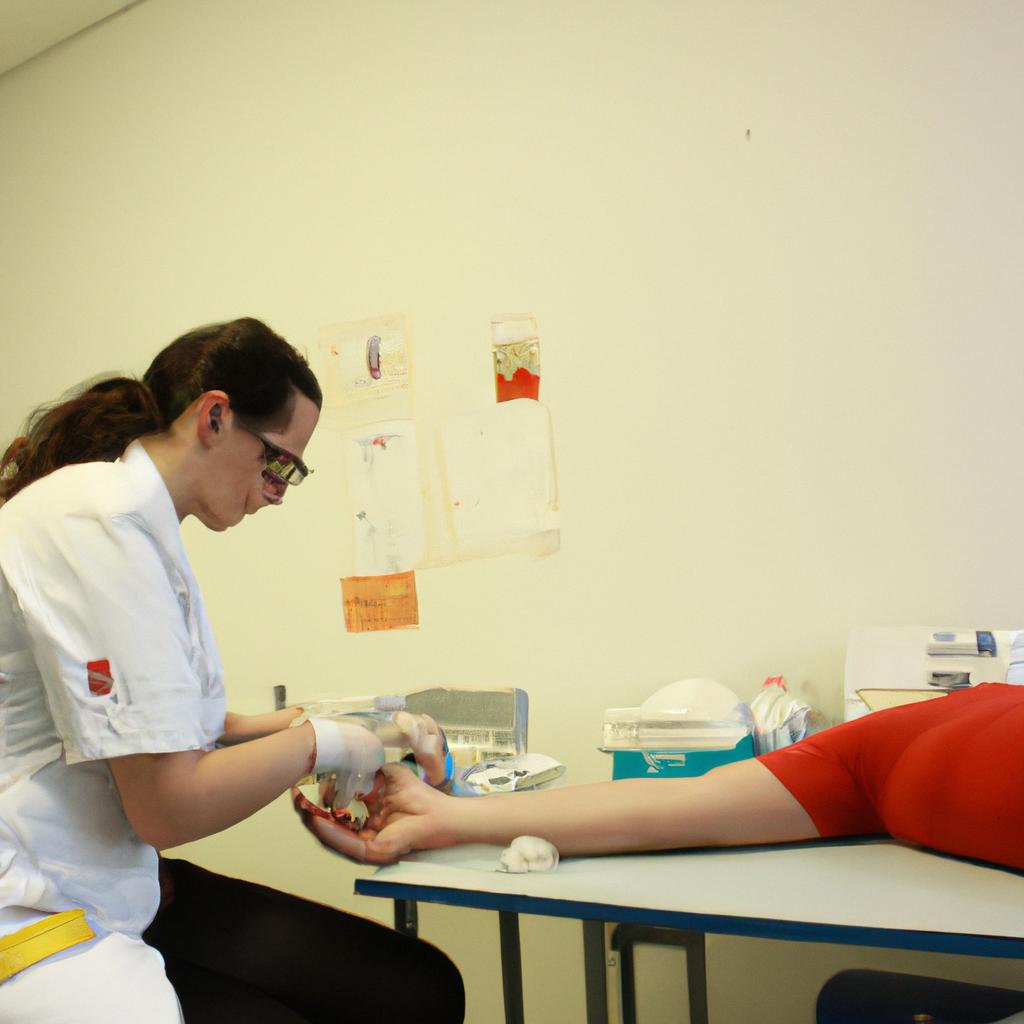Autoimmune Response in Body Myositis: Juvenile Myositis

Autoimmune response in body myositis, specifically juvenile myositis, is a complex and debilitating condition that affects the muscles of individuals, predominantly children. This autoimmune disorder occurs when the immune system mistakenly identifies its own muscle tissue as foreign and launches an attack against it. The consequences of this misdirected immune response can lead to significant muscle weakness, chronic inflammation, and long-term disability. To illustrate the gravity of this condition, consider the hypothetical case of a ten-year-old child named Emily who was diagnosed with juvenile myositis. Despite her young age and previously active lifestyle, Emily now struggles to perform basic motor functions due to severe muscle weakness.
The pathogenesis behind autoimmune response in body myositis involves various immunological mechanisms that contribute to the progression of the disease. Firstly, autoantibodies are produced by B cells targeting specific proteins within the muscle tissue. These autoantibodies bind to their respective antigens on muscle fibers, leading to complement activation and subsequent inflammation. Additionally, T lymphocytes play a crucial role in driving ongoing inflammation by releasing pro-inflammatory cytokines that further damage muscle tissue. Ultimately, these immunological processes perpetuate a destructive cycle where muscle fibers continue to be attacked by both innate and adaptive immune responses.
Understanding the Understanding the underlying mechanisms of autoimmune response in body myositis is crucial for developing effective treatment strategies and improving patient outcomes.
What is autoimmune response?
Autoimmune response refers to the body’s immune system mistakenly attacking its own healthy cells and tissues. This phenomenon can lead to various autoimmune diseases, including body myositis. To understand autoimmune response in the context of juvenile myositis, consider an example where a 10-year-old child named Sarah is diagnosed with this condition.
Sarah experiences muscle weakness, pain, and fatigue that progressively worsen over time. Initially, her parents dismiss these symptoms as normal childhood complaints. However, after several months of persistent discomfort and limited mobility, they seek medical attention. Following a series of diagnostic tests, Sarah is diagnosed with juvenile myositis – an autoimmune disease characterized by chronic inflammation in the muscles.
Understanding the complexity and impact of autoimmune response requires exploring some key aspects:
- Inflammatory Response: The immune system usually responds to foreign invaders like bacteria or viruses by triggering inflammation at the affected site. In cases of autoimmune diseases such as body myositis, however, the immune system mistakenly identifies self-tissues as threats and initiates inflammatory responses against them.
- Targeted Cells: In body myositis, specific cells within the muscles become targets of this misguided immune attack. These targeted cells include muscle fibers themselves and other components involved in muscle function.
- Pathological Mechanisms: The exact mechanisms underlying autoimmune response in body myositis are not completely understood yet. Researchers believe that genetic predisposition combined with environmental triggers may play a significant role in initiating this aberrant immune response.
- Consequences for Patients: Autoimmune response leading to body myositis has profound consequences on individuals’ daily lives. It can result in severe muscle weakness, difficulty performing everyday tasks, impaired mobility, joint stiffness, and decreased overall quality of life.
To illustrate how impactful these consequences can be emotionally:
| Emotional Impact | Description |
|---|---|
| Frustration | Struggling to perform simple movements |
| Isolation | Difficulty participating in social activities |
| Anxiety | Uncertainty about the disease progression |
| Depression | Feeling overwhelmed by chronic pain and limitations |
In conclusion, autoimmune response is a complex phenomenon characterized by the immune system targeting its own cells and tissues. In the case of body myositis, this misguided attack primarily affects muscle tissue. Understanding these processes allows us to comprehend how symptoms manifest in affected individuals. Now that we have explored autoimmune response, let us delve into the symptoms associated with body myositis.
What are the symptoms of body myositis?
Autoimmune Response in Body Myositis: Juvenile Myositis
In the previous section, we discussed what autoimmune response is and how it can impact the body. Now, let us delve into the specific symptoms associated with body myositis. To illustrate this further, consider the case of Sarah, a 12-year-old girl who was diagnosed with juvenile myositis last year.
Upon initial presentation, Sarah experienced muscle weakness and fatigue, particularly in her limbs. Simple tasks like climbing stairs or lifting objects became increasingly difficult for her. As time went on, she also noticed joint pain and swelling. These symptoms were accompanied by a rash on her face and knuckles that worsened when exposed to sunlight. Sarah’s parents took her to see a rheumatologist who confirmed the presence of an autoimmune response targeting her muscles – a characteristic feature of body myositis.
The symptoms observed in Sarah are not unique; they align with common indicators seen in individuals with body myositis. Here are some additional signs that may suggest its presence:
- Progressive muscle weakness over time
- Difficulty swallowing or speaking due to weakened throat muscles
- Muscle tenderness or soreness after periods of activity
- Fatigue that does not improve with rest
| Symptom | Description | Emotional Response |
|---|---|---|
| Muscle Weakness | Loss of strength in muscles resulting in difficulty performing daily activities | Frustration |
| Joint Pain | Discomfort or inflammation at joints | Discomfort |
| Rash | Skin eruption characterized by redness or discoloration | Concern |
| Fatigue | Extreme tiredness despite adequate rest | Exhaustion |
It is crucial to recognize these signs promptly as early intervention can help manage the condition effectively. By identifying and addressing the symptoms early on, individuals like Sarah can minimize the impact of body myositis on their daily lives.
As we have now explored the various manifestations of body myositis, let us proceed to understand how this condition is diagnosed. How do doctors determine if someone is indeed experiencing an autoimmune response affecting their muscles?
How is body myositis diagnosed?
Autoimmune Response in Body Myositis: Juvenile Myositis
Symptoms of body myositis can vary greatly among individuals, but they generally involve muscle weakness and inflammation. However, it is important to understand that the development and progression of body myositis are not solely reliant on muscular symptoms; rather, an autoimmune response within the body plays a crucial role.
The immune system’s primary function is to protect the body against harmful pathogens such as bacteria and viruses. In the case of body myositis, however, there is a malfunction in this defense mechanism. The immune system mistakenly identifies normal proteins present in muscle cells as foreign invaders and launches an attack against them. This abnormal immune response leads to chronic inflammation in the muscles, resulting in weakened muscle fibers over time.
To better comprehend how autoimmune responses contribute to the pathogenesis of body myositis, consider a hypothetical scenario involving a child named Emily who has been diagnosed with juvenile dermatomyositis (JDM). JDM is one type of body myositis that primarily affects children under the age of 18. In Emily’s case, her immune system starts attacking her own muscle cells due to a miscommunication between various components responsible for regulating immunity. Consequently, she experiences persistent muscle weakness and fatigue along with skin rashes – classic signs of JDM.
Understanding the impact of autoimmune responses in body myositis requires recognizing their consequences beyond muscular symptoms alone. Here are some key points highlighting these implications:
- The ongoing inflammation caused by autoimmunity can lead to joint pain and stiffness.
- Autoimmune responses may also affect other organs besides muscles, causing complications such as lung or heart problems.
- Individuals with body myositis often experience significant physical limitations that can impact daily activities.
- Emotional distress stemming from managing chronic illness alongside its physical manifestations is quite common among those affected by body myositiss.
To further illustrate these effects, refer to Table 1 below, which outlines the potential consequences of autoimmune response in body myositis:
Table 1: Consequences of Autoimmune Response in Body Myositis
| Effect | Description |
|---|---|
| Joint pain and stiffness | Inflammation can extend to joints, causing discomfort and reduced mobility. |
| Organ involvement | Other organs may be affected by autoimmunity, leading to additional health complications. |
| Physical limitations | Muscle weakness and fatigue often result in decreased physical abilities affecting daily life. |
| Emotional distress | The chronic nature of body myositis can lead to emotional challenges for individuals and their families. |
Understanding the impact of autoimmune responses is crucial when considering treatment options for body myositis. Therefore, the subsequent section will delve into various approaches that aim to alleviate symptoms and manage this complex condition effectively.
What are the treatment options for body myositis?
Autoimmune Response in Body Myositis: Juvenile Myositis
Diagnosis of body myositis can be challenging due to its varied clinical presentations and the need for multiple diagnostic tests. A comprehensive evaluation by a healthcare professional is crucial to arrive at an accurate diagnosis. For instance, let us consider the case of a 10-year-old boy presenting with muscle weakness and difficulty in climbing stairs. His physical examination reveals proximal muscle weakness and elevated levels of creatine kinase, an enzyme released into the bloodstream when muscles are damaged.
To confirm the suspicion of body myositis, several investigations may be recommended:
- Blood tests: These may include measuring specific autoantibodies associated with different subtypes of body myositis, such as anti-Jo-1 or anti-Mi2 antibodies.
- Electromyography (EMG): This test evaluates electrical activity in muscles using fine needle electrodes inserted into the affected muscles. EMG helps differentiate between primary muscle disorders and nerve-related problems.
- Muscle biopsy: A small sample of muscle tissue is extracted from an affected area and examined under a microscope to assess inflammation, degeneration, or other abnormalities.
- Imaging studies: Magnetic resonance imaging (MRI) scans can help identify areas of inflammation or damage within muscles.
Once these diagnostic procedures have been performed and analyzed collectively, a definitive diagnosis can be made based on established criteria for body myositis.
Treatment options for body myositis vary depending on disease severity, individual patient factors, and response to therapy. The goals of treatment aim to control symptoms, improve function, prevent complications, and minimize long-term disability. Treatment typically involves a multidisciplinary approach that combines medication management with physical therapy and occupational therapy.
Some commonly prescribed medications for managing body myositis include:
- Corticosteroids: These powerful anti-inflammatory drugs are often used initially to suppress the immune response and reduce muscle inflammation.
- Disease-modifying antirheumatic drugs (DMARDs): Medications like methotrexate or azathioprine may be prescribed in combination with corticosteroids to help maintain disease control and minimize steroid dependence.
- Biologic agents: In cases where conventional treatments are ineffective, biologic agents such as rituximab or tocilizumab can be considered to target specific parts of the immune system involved in body myositis.
Treatment plans are tailored to each individual patient’s needs, considering their age, overall health status, disease subtype, and any associated complications. Regular follow-up visits with healthcare professionals are essential for monitoring treatment effectiveness and adjusting therapy as necessary.
In summary, accurate diagnosis of body myositis requires a comprehensive evaluation involving various diagnostic tests. Once diagnosed, treatment options focus on managing symptoms and controlling the underlying autoimmune response. A multidisciplinary approach combining medication management and rehabilitation therapies is crucial for achieving optimal outcomes in patients with body myositis.
What are the potential complications of body myositis?
Treatment options for body myositis vary depending on the severity of the condition and individual patient factors. One example is a case study involving a 12-year-old boy diagnosed with juvenile dermatomyositis, a subtype of body myositis characterized by muscle weakness and skin rash. In this case, treatment began with high-dose corticosteroids to reduce inflammation and improve muscle strength. However, due to inadequate response, additional immunosuppressive medications such as methotrexate were introduced to target the underlying autoimmune response.
The management of body myositis involves a combination of pharmacological interventions and supportive measures. Here are some potential treatment strategies that may be employed:
-
Medications: Various medications can be used to suppress the immune system and manage inflammation in body myositis. These include corticosteroids like prednisone, which help alleviate symptoms by reducing inflammation; immunosuppressants like methotrexate or azathioprine, which dampen the immune system’s activity; and biologic agents such as rituximab or tocilizumab, which specifically target certain molecules involved in autoimmunity.
-
Physical therapy: Physical therapy plays a crucial role in managing body myositis by improving muscle strength, enhancing mobility, and preventing joint contractures caused by prolonged immobility. It typically includes exercises tailored to an individual’s capabilities and goals.
-
Occupational therapy: Occupational therapists assist patients in maintaining independence in daily activities despite muscle weakness or fatigue caused by body myositis. They suggest adaptive techniques, prescribe assistive devices if necessary (e.g., splints), and provide recommendations for modifications at home or work environments.
-
Psychological support: Body myositis can have significant physical and emotional impacts on individuals’ lives. Psychological counseling or support groups can help patients cope with challenges associated with their condition, providing them with resources to manage stress, anxiety, and depression.
To further understand these treatment options, consider the following table:
| Treatment Options | Description |
|---|---|
| Corticosteroids | High-dose corticosteroids are used to reduce inflammation and improve muscle strength. |
| Immunosuppressants | Medications like methotrexate or azathioprine dampen the immune system’s activity to manage autoimmune response. |
| Biologic agents | Rituximab or tocilizumab specifically target certain molecules involved in autoimmunity. |
| Physical therapy | Exercises tailored to an individual’s capabilities help improve muscle strength, mobility, and prevent contractures. |
| Occupational therapy | Assist patients in maintaining independence through adaptive techniques and assistive devices if needed. |
| Psychological support | Counseling or support groups can help individuals cope with emotional challenges associated with body myositis. |
In conclusion, treatment for body myositis typically involves a combination of medications to suppress the immune response, physical and occupational therapies to enhance muscle function and maintain independence, as well as psychological support to address emotional well-being. With proper management strategies in place, individuals living with body myositis can experience improved quality of life and better control over their symptoms.
Moving forward, let us explore how body myositis can be managed and prevented.
How can body myositis be managed and prevented?
Potential complications of body myositis can significantly impact an individual’s quality of life. One example is the development of interstitial lung disease (ILD), which affects up to 70% of patients with myositis. ILD refers to a group of disorders characterized by inflammation and scarring in the lungs, leading to impaired oxygen exchange and respiratory symptoms such as shortness of breath and coughing.
In addition to ILD, other potential complications associated with body myositis include:
- Dysphagia: Some individuals may experience difficulty swallowing due to muscle weakness in the throat and esophagus. This can lead to choking episodes, malnutrition, and weight loss.
- Cardiac involvement: Myocarditis, inflammation of the heart muscle, can occur in some cases of body myositis. It may result in arrhythmias or heart failure.
- Joint contractures: Prolonged muscle weakness and immobility can cause joint stiffness and contractures, limiting range of motion and causing functional impairment.
- Skin manifestations: Dermatomyositis, a subtype of body myositis, often presents with skin changes such as a characteristic rash called heliotrope rash on the eyelids or Gottron’s papules over the knuckles.
To better understand the potential complications associated with body myositis, we have prepared a table summarizing their prevalence rates based on available literature:
| Complication | Prevalence Rate |
|---|---|
| Interstitial Lung Disease | Up to 70% |
| Dysphagia | Varied |
| Cardiac Involvement | Less than 10% |
| Joint Contractures | Varied |
It is important for healthcare providers managing patients with body myositis to be aware of these potential complications and incorporate appropriate monitoring strategies into their care plans. Early detection and intervention are crucial in minimizing the impact of these complications on patients’ overall health and well-being.
In summary, body myositis can give rise to various potential complications, including interstitial lung disease, dysphagia, cardiac involvement, joint contractures, and skin manifestations. Healthcare professionals should remain vigilant in monitoring for these complications to ensure timely intervention when necessary. By addressing these issues proactively, clinicians can help improve outcomes and enhance the quality of life for individuals with body myositis.






